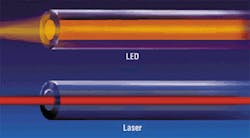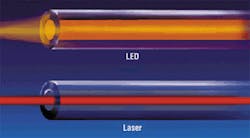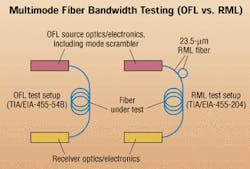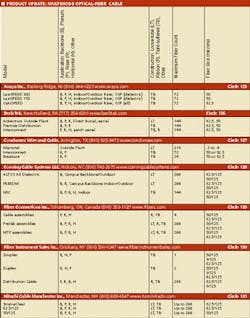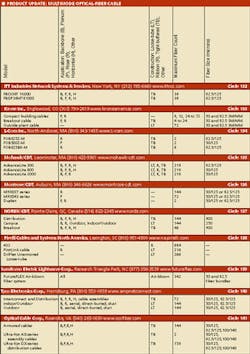New VCSEL procedure proves ideal for short wavelengths.
The ever-increasing demand for faster data speed rates has generated tremendous technological advances, permitting transmission over longer distances and at higher speeds. The advancements have resulted in the release of high data- rate standards, such as the basic Gigabit Ethernet standard (IEEE 802.3), changing how multimode opticalfiber bandwidth (i.e., the standard 62.5-µm and the more advantageous 50-µm) is specified. As networks continue their move to higher rates, viable commercial products quickly follow. A new fiber bandwidth measurement procedure has been implemented to support the use of laser sources on multimode fiber-specifically at the 850-nm wavelength region.
One such related technical advancement is the vertical-cavity surface-emitting laser (VCSEL), a light source that has been proven to be ideal for multimode fiber, operating in the 850-nm short-wavelength region. As a comparatively inexpensive light source coupled with multi-gigabit speeds, the VCSEL offers increased system reach and bandwidth capabilities. In spite of industry advances, new testing methods for multimode fiber have remained a comparative dinosaur among a new breed of optical fiber solutions, and a standard procedure for measuring bandwidth when utilizing VCSEL systems was non-existent. In response, a new bandwidth testing method for multimode fiber has been developed to simulate the VCSEL launch in Gigabit Ethernet applications.
Traditionally, multimode fiber bandwidth was measured by overfilled launch (OFL) bandwidth in support of data applications using LED sources. OFL testing served the industry well for many years, enabling network designers to understand how their systems would perform. But OFL's capabilities were limited. Although OFL bandwidth measurement is an excellent predictor of bandwidth for fibers using LEDs, it has been proven inadequate for characterizing laser-based performance.
Putting the VCSEL in focus
A VCSEL concentrates the light pulses into a much smaller area, resulting in fewer modes being transmitted down the fiber. Limiting the number of modes generally decreases the system's modal dispersion and increases bandwidth.
But, there is an additional issue that results from reducing the spot size of the transmitter. A multimode fiber's index profile contains numerous rings of glass, which when put together, guide the various modes of each light pulse down the fiber at essentially the same speed. Due to the complexity of the manufacturing process for multimode fiber, it is possible to introduce flaws into the fiber's index profile, affecting how light enters and travels down the fiber at and from the point of the flaw. If present, especially in the central region of the core, these flaws are relatively minor when compared to the area of a multimode fiber core that is flooded with light from an LED. But when compared to the spot size of a VCSEL or laser source, flaws can become significant and can degrade the system performance.
Measuring multimode with RML
Enter a new development in multimode testing-restricted mode launch (RML). This is the first method of measuring bandwidth that lets users accurately predict VCSEL performance in laser-based applications. Unlike OFL bandwidth measurements, RML simulates VCSEL performance in a laser-based system by concentrating light pulses in the fiber's much narrower center region. This concentration of light in the fiber core results in fewer modes being transmitted down the fiber. By limiting the number of modes, modal dispersion is decreased while enhancing bandwidth capability.
How is RML measured? Simulating launch conditions is in accordance with standard bandwidth procedures, with one exception. The overfilled launch condition is filtered with a mode-conditioning patch cord. The patch cord consists of special RML fiber, which has a graded-index profile with a 23.5-µm core and a 0.208 numerical aperture. Filtering the OFL gives way to a RML condition for the bandwidth measurement.
Like LEDs, the output power of a VCSEL is not strong enough for measuring fiber bandwidth in the lengths to which bare fiber is manufactured. Therefore, laser test sources must be conditioned to mimic a VCSEL, just as they are conditioned to mimic an LED per the Mode Scrambler Requirements for Overfilled Launching Conditions to Multimode Fibers (TIA/EIA-455-54B). To accomplish this, a 23.5-µm fiber with a graded-index profile is used to achieve launch characteristics that are representative of what is produced by a typical VCSEL. The special RML fiber conditions the OFL launch pulse before it enters the fiber under test. The figure on this page illustrates a generic test setup.
Leading RML research and standards development was the Modal Dependence of Multimode Fiber Bandwidth (TIA FO-2.2.1) task group, led by Mike Hackert, a measurement project engineer at Corning Incorporated (www.corning.com). The task group, with representatives from major fiber and several leading VCSEL manufacturers, successfully developed the RML bandwidth measurement procedures that resulted in the release of the Launched Power Distribution Measurement Procedure for Graded-Index Multimode Fiber Transmitters (TIA/EIA-455-203) and Measurement of Bandwidth on Multimode Fiber (TIA/EIA-455-204). TIA correlated RML bandwidth to performance of VCSELs at links that are typical in LANs, and approved the RML procedures.
Accurate performance measurement
Until recently, there was not a standard measurement for laser bandwidth when used in VCSEL-based networks. Therefore, various manufacturers used a variety of measurement methods. Although all of the various processes provide equivalent OFL measurements, these fibers could have limitations on their laser performance.
Unlike extended link-length claims based on OFL bandwidth alone, RML bandwidth provides a measurable and accurate specification of fiber performance when used in laser-based systems in high-speed networks. RML bandwidth lets users predict performance in laser-based networks like Gigabit Ethernet. It provides a repeatable method for gauging fiber performance under laser launch conditions, and allows verification of a specification parameter. Guaranteed minimum cabled fiber RML bandwidth values provide installers, consultants, and users with the ability to specify a meaningful performance parameter. When specifying network infrastructures, designers need to make sure cabled RML bandwidth is specified to guarantee Gigabit Ethernet system link performances. Specifying cabled RML bandwidth ensures the proper operation of the fiber in a laser-based system.
Doug Colemanis manager of technology and standards strategy, Corning Cable Systems (www.corningcablesystems.com).
Clarification
In the Product Update of the September issue, a table on page 66 lists the splice time after fiber preparation. Sumitomo Electric Lightwave Corp. (www.sumitomoelectric.com) says specific splice times for its three featured fusion splicers are: The Type-45S and Type-37 have splice times of less than 17 seconds, and the Type-65 offers a 30-second splice time.
null
null
